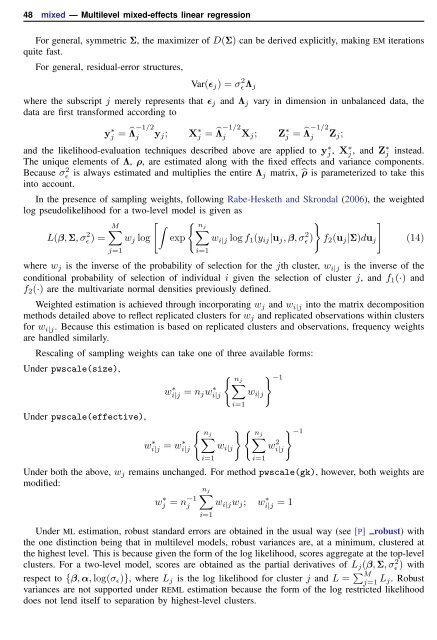mixed - Stata
mixed - Stata
mixed - Stata
You also want an ePaper? Increase the reach of your titles
YUMPU automatically turns print PDFs into web optimized ePapers that Google loves.
48 <strong>mixed</strong> — Multilevel <strong>mixed</strong>-effects linear regression<br />
For general, symmetric Σ, the maximizer of D(Σ) can be derived explicitly, making EM iterations<br />
quite fast.<br />
For general, residual-error structures,<br />
Var(ɛ j ) = σ 2 ɛ Λ j<br />
where the subscript j merely represents that ɛ j and Λ j vary in dimension in unbalanced data, the<br />
data are first transformed according to<br />
y ∗ j = ̂Λ−1/2<br />
j y j ; X ∗ j = ̂Λ−1/2<br />
j X j ; Z ∗ j = ̂Λ−1/2<br />
j Z j ;<br />
and the likelihood-evaluation techniques described above are applied to yj ∗, X∗ j , and Z∗ j instead.<br />
The unique elements of Λ, ρ, are estimated along with the fixed effects and variance components.<br />
Because σɛ 2 is always estimated and multiplies the entire Λ j matrix, ̂ρ is parameterized to take this<br />
into account.<br />
In the presence of sampling weights, following Rabe-Hesketh and Skrondal (2006), the weighted<br />
log pseudolikelihood for a two-level model is given as<br />
[<br />
M∑ ∫ { nj<br />
} ]<br />
∑<br />
L(β, Σ, σɛ 2 ) = w j log exp w i|j log f 1 (y ij |u j , β, σɛ 2 ) f 2 (u j |Σ)du j (14)<br />
j=1<br />
i=1<br />
where w j is the inverse of the probability of selection for the jth cluster, w i|j is the inverse of the<br />
conditional probability of selection of individual i given the selection of cluster j, and f 1 (·) and<br />
f 2 (·) are the multivariate normal densities previously defined.<br />
Weighted estimation is achieved through incorporating w j and w i|j into the matrix decomposition<br />
methods detailed above to reflect replicated clusters for w j and replicated observations within clusters<br />
for w i|j . Because this estimation is based on replicated clusters and observations, frequency weights<br />
are handled similarly.<br />
Rescaling of sampling weights can take one of three available forms:<br />
Under pwscale(size),<br />
Under pwscale(effective),<br />
w ∗ i|j = n jw ∗ i|j<br />
w ∗ i|j = w∗ i|j<br />
{ nj<br />
{ nj<br />
} −1<br />
∑<br />
w i|j<br />
i=1<br />
} {<br />
∑ ∑<br />
nj<br />
w i|j<br />
i=1<br />
Under both the above, w j remains unchanged. For method pwscale(gk), however, both weights are<br />
modified:<br />
n<br />
∑ j<br />
wj ∗ = n −1<br />
j w i|j w j ; wi|j ∗ = 1<br />
i=1<br />
Under ML estimation, robust standard errors are obtained in the usual way (see [P] robust) with<br />
the one distinction being that in multilevel models, robust variances are, at a minimum, clustered at<br />
the highest level. This is because given the form of the log likelihood, scores aggregate at the top-level<br />
clusters. For a two-level model, scores are obtained as the partial derivatives of L j (β, Σ, σɛ 2 ) with<br />
respect to {β, α, log(σ ɛ )}, where L j is the log likelihood for cluster j and L = ∑ M<br />
j=1 L j. Robust<br />
variances are not supported under REML estimation because the form of the log restricted likelihood<br />
does not lend itself to separation by highest-level clusters.<br />
i=1<br />
w 2 i|j<br />
} −1
















